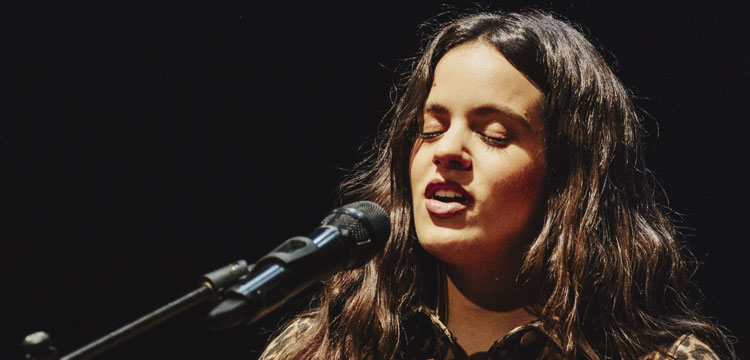Voice: Rosalía. Guitar: Joselito Acedo. Rhythm: Los Mellis. Chorus: Anna Colom and Claudia ‘La Chispa’. Café Alameda. September 28th, 2018. Full house.
Sara Arguijo
Inside, the groupies, the tacky people, the pungent personalities, the romantic dreamers, the hipsters, the pseudo-modern, the trendy politicians and the adolescent instagrammers. Outside, hundreds of curiosity seekers prepared to pay for more than one round in order to get one of the 300 tickets (the first to sell out in the Bienal) to get to be an authoritative voice in what has been the mainstream flamenco debate over the last few months. In actual fact, more for snobbism than genuine interest, no one wanted to miss the first concert Rosalía offered in the Seville event, nor give up the chance to brag “I was there”.
And so, knowing how she generates this thing, and completely aware of the niche she can and wants to fill, the Catalonian offered a recital studied down to the last millimeter, but passed, or actually posed through a filter of naturalness. Telling a story in which she situates herself in the precise point between arrogance and naïveté, between sweetness and boldness, between security and vulnerability, between seduction and detachment.
Exactly the same thing she does with her music, “that you can call flamenco, pop or whatever you want because I’m not even sure what to call it any more”, she said smiling, with the same intelligence other singers tell you their fears before opening their mouths in order to keep the spectators’ expectations at bay. In other words, for this artist, flamenco and urban music are resources in which she finds details with which to decorate her line, and also to glaze over her shortcomings, depending on the moment.
In this sense, she strolls through flamenco superficially, turning flamenco forms into pop songs, probably in order to avoid delving into the depths so no one notices her limitations, her bad vocal habits and lack of rhythm. Which is why the light repertoire (granaína, tanguillos, guajira, bulerías, rumba, fandangos…) in which she relied on some of her favorites, such as Vallejo, Chacón, Marchena and Pastora Pavón, fell flat for those hoping for something substantial with which to defend her supposed flamenco revolution, despite the fact that the guitar of Joselito Acedo accompanied her well and gave a place to her singing that Raúl Refree did not. And by the same token, it was boring for those others who wanted to see her in action in a street-wise show that would include her hit song Malamente as one shouted from the audience.
In any case, the artist manages to get you hooked and achieves an interesting result because what she does is fresh and accessible for all listeners, and basically, because on a melodic level it sounds pretty. Despite the fact that this is the most attractive thing about her, her melodious voice, the turns and tonal decoration (courtesy of the Taller de Musics), ends up cloyingly repetitive. Of course, in an era when the concept of recordings as works has been lost and it’s the consumer who selects his own playlist, this is nearly insignificant regarding sales.
Certainly, more than because of her talent, which she clearly has although it needs to be developed, the Catalonian comes out on top because she’s clever, intuitive and knows how to act like an artist. Her objective is clear, and like any other millennial, she no longer bears the burden inherited from the postwar of considering struggle a virtue and apologizing for being triumphant. That leads to her sprawling on her chair, interrupting her singing to cough, getting up and sitting down whenever she feels like it and singing with the indigestion of having swallowed the world whole. Lots of posturing. To put it another way, it makes no difference how much truth there might or might not be in the many labels that have been attached to her because in the end, Rosalía says more about us and our hang-ups than about herself.
